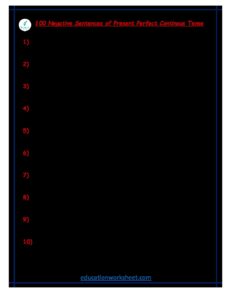Present Perfect Continuous Tense examples Worksheets
Present Perfect Continuous Tense examples Worksheets
Structure and Formation of Present Perfect Continuous Tense:
Before delving into examples, let’s establish the structure and formation of the Present Perfect Continuous tense. It is created using the following formula:
Subject + have/has + been + verb-ing (present participle) + [time expression]
Here, “have” is used with subjects like “I,” “you,” “we,” and “they,” while “has” is used with “he,” “she,” and “it.” “Been” is a consistent part of the structure, and the present participle form of the verb, which ends in “-ing,” is used. Time expressions are optional but can be added to specify the duration or the starting point of the action.
Now, let’s dive into a wide array of examples that showcase the Present Perfect Continuous tense in various contexts:
Actions Started in the Past and Continue into the Present:

- She has been practicing yoga for five years.
- They have been living in this neighborhood since 2010.
- I have been working on this project all morning.
- The children have been playing in the park for hours.
In these examples, the actions (practicing yoga, living in the neighborhood, working on the project, playing in the park) all started at some point in the past and continue into the present moment.
Emphasizing Duration:
- He has been studying for his exams for six hours.
- We have been traveling around Europe for two weeks.
- She has been painting the house since yesterday.
- They have been talking on the phone for ages.
These examples emphasize the duration of the action, indicating that the action has been ongoing for a specific period.
Expressing Temporary Situations:
- I have been feeling a bit under the weather lately.
- She has been wearing glasses since last week.
- They have been staying at a hotel while their house is being renovated.
- He has been acting strangely recently.
Here, the Present Perfect Continuous tense is used to describe temporary situations or conditions that have been occurring recently.
Present Perfect Continuous Tense examples

Actions with Present Consequences:
- I have been exercising regularly, and I feel much healthier.
- She has been studying hard, so she’s well-prepared for the exam.
- They have been saving money, and now they can afford a vacation.
- He has been practicing the guitar, and his skills have improved.
These examples illustrate how the Present Perfect Continuous tense is employed in professional and academic contexts to describe ongoing research or work.
Emphasizing Repetition:
- She has been visiting her grandmother every weekend.
- They have been attending the yoga class regularly.
- I have been reading a chapter from that book every night.
- He has been volunteering at the animal shelter every Saturday.
These sentences emphasize the repeated or habitual nature of the actions.
Actions Interrupted by Other Events:
- He has been cooking dinner when the power went out.
- She has been working on her computer when the phone rang.
- They have been hiking in the mountains when it started raining.
These examples show actions that were interrupted by another event.
Describing Ongoing Experiences:
- She has been experiencing a lot of stress lately.
- They have been enjoying their time in the new city.
- I have been loving every moment of this vacation.
- He has been feeling a sense of accomplishment with his recent achievements.
In these sentences, the Present Perfect Continuous tense is used to describe ongoing experiences or feelings.
Actions with Multiple People:
- We have been planning this surprise party for weeks.
- They have been rehearsing for the school play together.
- I have been discussing the project with my colleagues.
- She has been collaborating with artists from around the world.
These sentences convey concern or worry about ongoing actions or situations.
Expressing Actions in Passive Voice:
- The house has been being renovated for months.
- The documents have been being reviewed by the legal team.
- The project has been being managed by an experienced team.
- The cake has been being baked for an hour.
In passive voice, the Present Perfect Continuous tense is used to describe ongoing actions performed by an unspecified or general subject.
Emphasizing the Ongoing Nature:
- She has been constantly working on her novel.
- They have been tirelessly advocating for social justice.
- I have been diligently practicing my guitar skills.
- He has been consistently attending therapy sessions.
These examples highlight the continuous and unrelenting nature of the actions.

